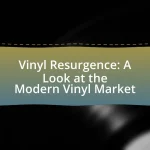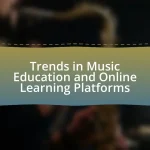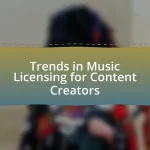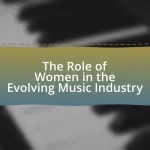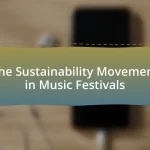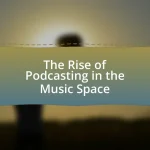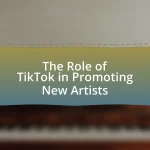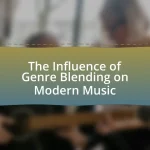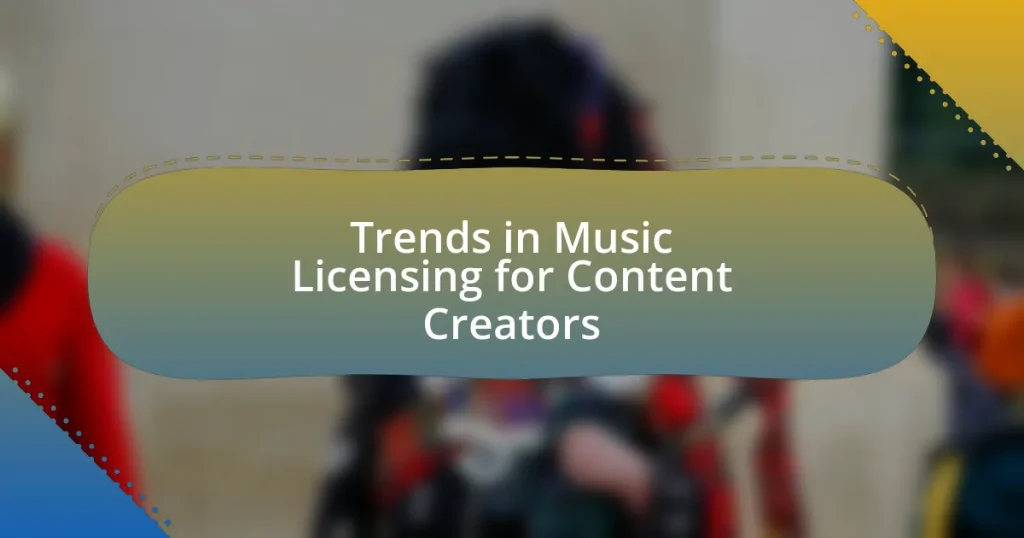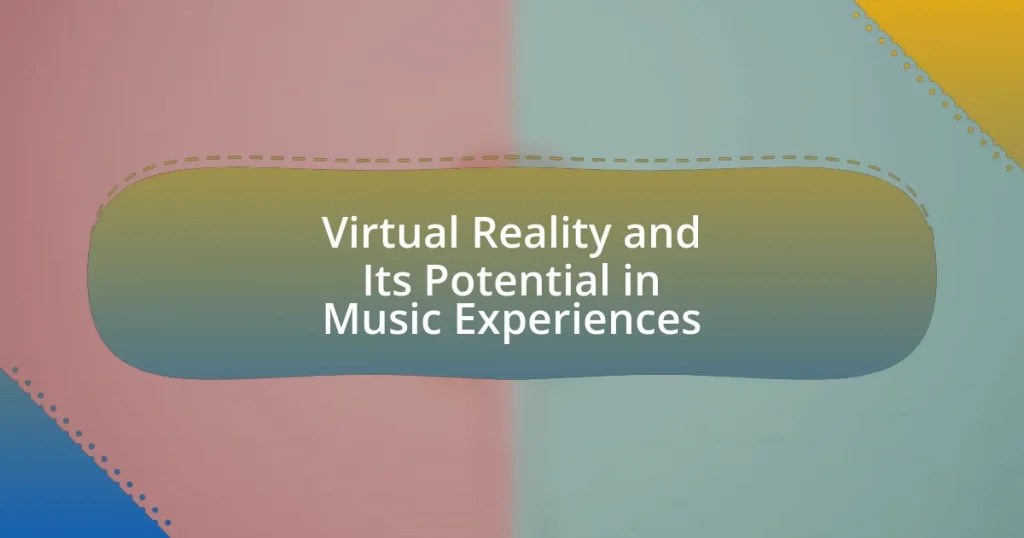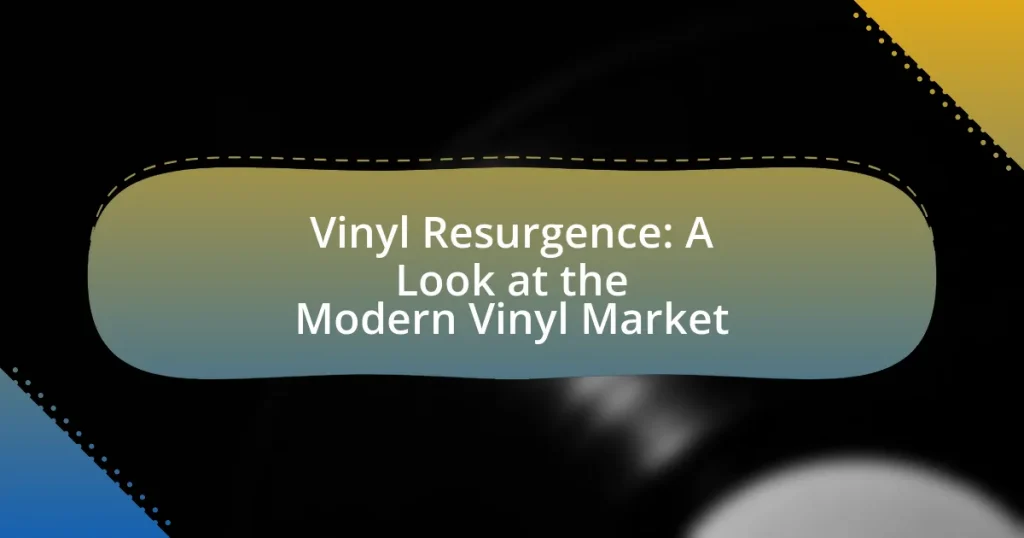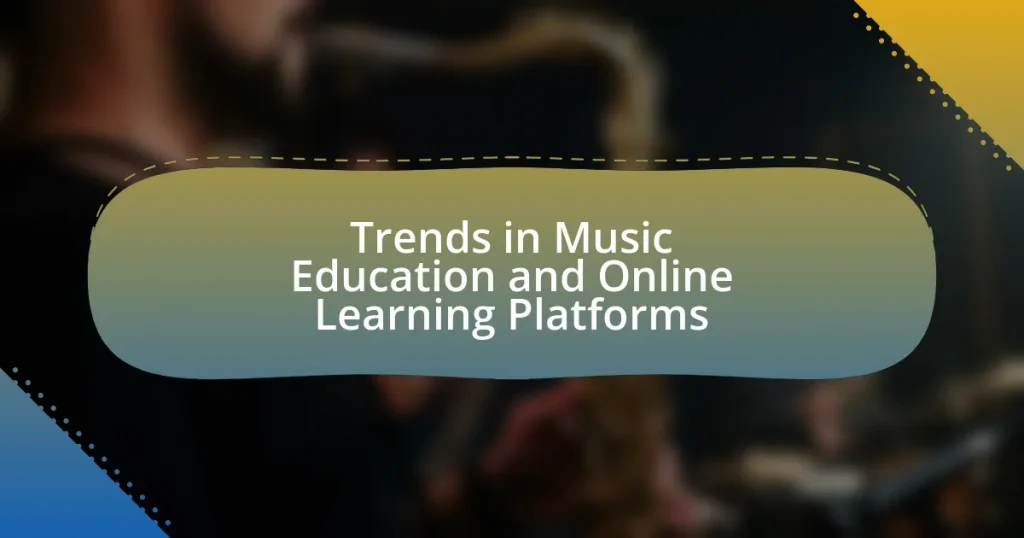The article focuses on current trends in music licensing for content creators, highlighting the rise of subscription-based platforms, increased use of royalty-free music, and the importance of clear licensing agreements. It examines how the landscape of music licensing has evolved due to digital platforms and changing consumer behavior, emphasizing the role of streaming services in facilitating music distribution and compensation for rights holders. Additionally, the article discusses technological advancements influencing licensing, the legal implications of improper licensing, and best practices for content creators to navigate the complexities of music licensing effectively.
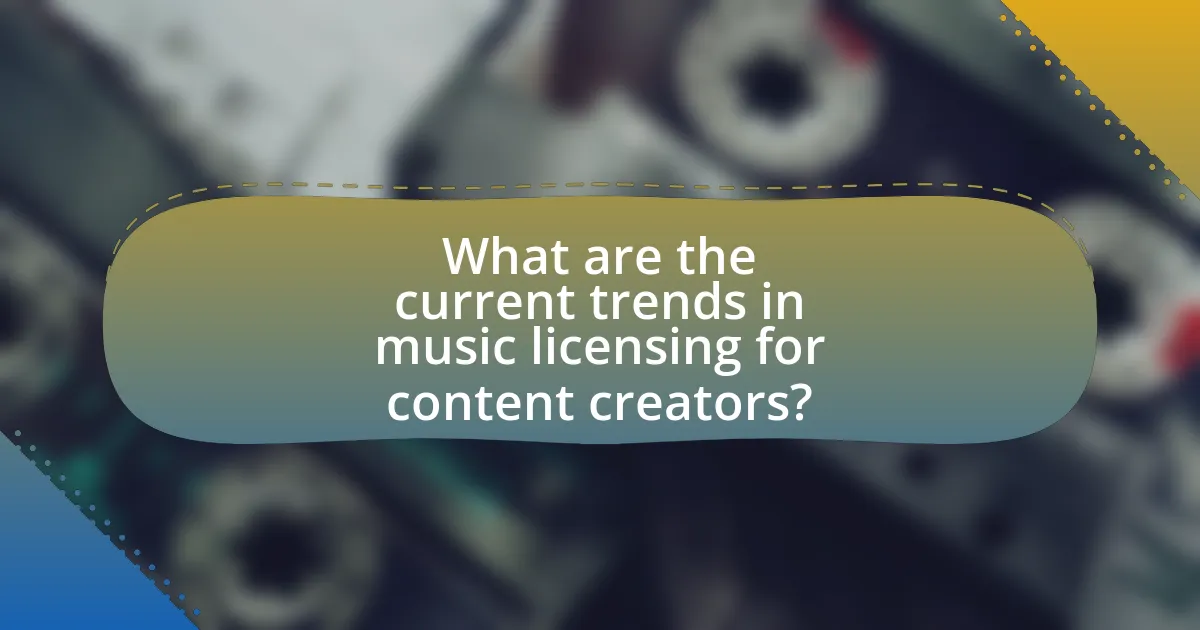
What are the current trends in music licensing for content creators?
Current trends in music licensing for content creators include the rise of subscription-based licensing platforms, increased use of royalty-free music, and the growing importance of clear licensing agreements. Subscription-based platforms, such as Epidemic Sound and Artlist, allow creators to access extensive music libraries for a flat fee, simplifying the licensing process. Additionally, the popularity of royalty-free music has surged, as creators seek cost-effective options without the complexities of traditional licensing. Furthermore, the emphasis on clear licensing agreements has become crucial, as content creators aim to avoid copyright disputes and ensure compliance with platform policies. These trends reflect the evolving landscape of music licensing, driven by the needs of content creators in a digital environment.
How has the landscape of music licensing evolved in recent years?
The landscape of music licensing has evolved significantly in recent years, primarily driven by the rise of digital platforms and the increasing demand for content creation. The proliferation of streaming services and social media has led to a greater need for accessible and affordable music licensing options, prompting the emergence of user-friendly licensing platforms that cater specifically to content creators. For instance, services like Epidemic Sound and Artlist have gained popularity by offering subscription-based models that allow creators to use a vast library of music without the complexities of traditional licensing agreements. Additionally, changes in copyright laws and the enforcement of fair use have influenced how music is licensed, making it essential for creators to navigate these regulations carefully. This evolution reflects a shift towards more flexible and creator-friendly licensing solutions, enabling a broader range of individuals and businesses to incorporate music into their projects legally and efficiently.
What technological advancements are influencing music licensing?
Technological advancements such as blockchain, artificial intelligence, and digital distribution platforms are significantly influencing music licensing. Blockchain technology enhances transparency and efficiency in tracking music rights and royalties, allowing for real-time payments and reducing disputes. Artificial intelligence streamlines the licensing process by automating tasks like rights management and music identification, which improves accuracy and reduces administrative burdens. Additionally, digital distribution platforms facilitate easier access to licensed music, enabling content creators to find and use music more efficiently while ensuring proper licensing compliance. These advancements collectively reshape the landscape of music licensing, making it more accessible and efficient for creators.
How are changes in consumer behavior affecting music licensing trends?
Changes in consumer behavior are significantly impacting music licensing trends by increasing demand for flexible and affordable licensing options. As consumers shift towards streaming services and user-generated content platforms, content creators require music that is easily accessible and cost-effective. This shift has led to a rise in subscription-based licensing models and the popularity of royalty-free music, as creators seek to avoid complex licensing agreements and high fees associated with traditional music licensing. According to a report by the International Federation of the Phonographic Industry (IFPI), the global recorded music market grew by 7.4% in 2021, driven by streaming, which indicates a direct correlation between consumer preferences for on-demand music and the evolution of licensing practices.
What role do streaming platforms play in music licensing?
Streaming platforms serve as intermediaries in music licensing by facilitating the distribution of music while ensuring that rights holders receive compensation. These platforms negotiate licensing agreements with record labels, publishers, and performing rights organizations to legally stream music. For instance, Spotify and Apple Music pay royalties based on the number of streams, which are calculated through complex algorithms that account for user engagement and subscription models. This system not only provides artists with exposure but also generates revenue, as evidenced by the $1.2 billion paid in royalties by Spotify in 2020 alone. Thus, streaming platforms play a crucial role in the modern music licensing landscape by balancing access for consumers with fair compensation for creators.
How do different streaming services approach music licensing?
Different streaming services approach music licensing through various models tailored to their business strategies and user experiences. For instance, Spotify primarily utilizes a combination of direct licensing agreements with record labels and performance rights organizations, allowing them to offer a vast catalog of music while paying royalties based on user engagement metrics. In contrast, Apple Music focuses on exclusive deals with artists and labels, often securing rights for specific albums or tracks to enhance its competitive edge. YouTube Music, on the other hand, relies heavily on user-generated content and ad-supported models, negotiating licenses that allow for a broader range of music while monetizing through advertisements. These approaches reflect the distinct business models and target audiences of each service, influencing how they negotiate and manage music rights.
What impact do licensing agreements have on content creators using these platforms?
Licensing agreements significantly affect content creators by determining their legal rights to use music in their projects. These agreements can either facilitate access to a wide range of music, allowing creators to enhance their content, or impose restrictions that limit their creative freedom and potential revenue. For instance, platforms like YouTube and TikTok have specific licensing arrangements that enable creators to use popular songs, which can increase audience engagement and monetization opportunities. Conversely, strict licensing terms may lead to content removal or demonetization if creators fail to comply, as seen in cases where unauthorized music use results in copyright claims. Thus, the nature of licensing agreements directly influences both the creative process and the financial viability of content creation on these platforms.
Why is understanding music licensing important for content creators?
Understanding music licensing is crucial for content creators because it ensures legal compliance and protects against copyright infringement. Content creators who use music without proper licensing risk facing legal actions, including fines and removal of their content. According to the U.S. Copyright Office, unauthorized use of copyrighted music can lead to statutory damages ranging from $750 to $30,000 per infringement, emphasizing the financial risks involved. Additionally, understanding licensing helps creators select appropriate music that aligns with their brand and audience, enhancing the overall quality and appeal of their content.
What legal implications arise from improper music licensing?
Improper music licensing can lead to significant legal implications, including copyright infringement claims, financial penalties, and potential lawsuits. When content creators use music without obtaining the necessary licenses, they violate the rights of the copyright holder, which can result in legal action against them. For instance, the U.S. Copyright Act allows copyright owners to sue for statutory damages ranging from $750 to $30,000 per work infringed, and in cases of willful infringement, damages can escalate to $150,000 per work. Additionally, unauthorized use of music can lead to the removal of content from platforms, loss of revenue, and damage to reputation. These legal consequences underscore the importance of securing proper licenses before using music in any content creation.
How can content creators protect themselves through proper licensing?
Content creators can protect themselves through proper licensing by obtaining the necessary rights to use music and other copyrighted materials in their work. This involves securing licenses such as synchronization licenses for pairing music with visual content, mechanical licenses for reproducing music, and performance licenses for public performances. According to the U.S. Copyright Office, failure to obtain these licenses can lead to legal repercussions, including copyright infringement claims, which can result in financial penalties and the removal of content. By proactively managing licensing agreements, content creators can ensure they have the legal right to use the materials, thereby safeguarding their creative output and financial interests.
What are the emerging models of music licensing for content creators?
Emerging models of music licensing for content creators include subscription-based services, direct licensing agreements, and royalty-free music platforms. Subscription-based services, such as Epidemic Sound and Artlist, allow creators to pay a monthly fee for access to a vast library of music, simplifying the licensing process. Direct licensing agreements enable content creators to negotiate terms directly with artists or labels, fostering a more personalized approach. Additionally, royalty-free music platforms provide tracks that can be used without ongoing fees, appealing to budget-conscious creators. These models reflect the evolving landscape of music licensing, driven by the need for flexibility and accessibility in content creation.
How do subscription-based models differ from traditional licensing?
Subscription-based models differ from traditional licensing primarily in their payment structure and access rights. In subscription-based models, users pay a recurring fee for ongoing access to a library of content, allowing for flexibility and continuous updates, while traditional licensing typically involves a one-time payment for specific usage rights of a particular piece of content. For example, in the music industry, platforms like Spotify and Apple Music operate on a subscription basis, providing users with unlimited access to a vast catalog of songs, whereas traditional licensing would require a creator to pay for each individual track they wish to use in their content. This shift towards subscription models reflects a growing trend in music licensing, catering to the needs of content creators who prefer predictable costs and broader access to resources.
What are the benefits of using royalty-free music for content creators?
Using royalty-free music provides content creators with significant benefits, including cost-effectiveness, legal safety, and creative flexibility. Cost-effectiveness arises because royalty-free music typically requires a one-time fee or is available for free, allowing creators to access high-quality audio without ongoing expenses. Legal safety is ensured as royalty-free music eliminates the risk of copyright infringement, which can lead to costly legal disputes and content removal. Creative flexibility is enhanced since creators can choose from a vast library of genres and styles, enabling them to find the perfect soundtrack that aligns with their content’s tone and message. These advantages make royalty-free music an essential resource for content creators looking to enhance their projects efficiently and legally.
How can content creators navigate the complexities of music licensing?
Content creators can navigate the complexities of music licensing by understanding the different types of licenses available, such as synchronization licenses for using music in videos and mechanical licenses for reproducing music. Familiarity with licensing platforms, like ASCAP and BMI, helps creators access a wide range of music while ensuring compliance with copyright laws. Additionally, utilizing royalty-free music libraries or Creative Commons licensed tracks can simplify the process, as these options often come with clear usage guidelines. According to a 2021 report by the Music Industry Association, over 60% of content creators reported using licensed music to enhance their projects, highlighting the importance of proper licensing in maintaining legal and ethical standards.
What resources are available for understanding music licensing?
Resources available for understanding music licensing include online platforms, educational websites, and industry organizations. Websites like the American Society of Composers, Authors and Publishers (ASCAP) and the Broadcast Music, Inc. (BMI) provide comprehensive guides and articles on licensing processes. Additionally, the Music Licensing Guide by the U.S. Copyright Office offers detailed information on copyright laws and licensing requirements. Industry organizations such as the National Music Publishers’ Association (NMPA) also provide resources and advocacy for music licensing issues. These resources are essential for content creators to navigate the complexities of music licensing effectively.
How can content creators effectively negotiate licensing agreements?
Content creators can effectively negotiate licensing agreements by clearly understanding their rights and the value of their work. They should conduct thorough research on industry standards and comparable licensing deals to establish a strong negotiating position. Additionally, creators must articulate their unique value proposition, demonstrating how their content can benefit the licensee, which can justify higher fees or more favorable terms.
For instance, a study by the Music Industry Research Association found that creators who present data on audience engagement and reach during negotiations are more likely to secure better licensing terms. By preparing a well-documented case that highlights their audience metrics and previous successes, content creators can enhance their bargaining power and achieve more favorable licensing agreements.
What best practices should content creators follow in music licensing?
Content creators should obtain proper licenses for all music used in their projects to avoid legal issues. This includes understanding the different types of licenses, such as synchronization licenses for video content and mechanical licenses for audio recordings. Additionally, creators should keep detailed records of all licensing agreements and ensure that they comply with the terms, including payment of royalties when applicable. According to the U.S. Copyright Office, failure to secure the appropriate licenses can lead to copyright infringement claims, which can result in significant financial penalties.
How can content creators ensure compliance with licensing regulations?
Content creators can ensure compliance with licensing regulations by thoroughly researching and understanding the specific licensing requirements for the music they intend to use. This involves obtaining the necessary licenses from rights holders, such as music publishers and performing rights organizations, to legally use copyrighted material. For instance, the U.S. Copyright Office states that using music without proper licensing can lead to legal repercussions, including fines and removal of content. Additionally, creators should keep detailed records of all licenses acquired and consult legal experts when in doubt about compliance to avoid potential infringements.
What strategies can help content creators maximize their use of licensed music?
Content creators can maximize their use of licensed music by strategically selecting tracks that align with their brand identity and audience preferences. This involves researching music libraries to find tracks that not only fit the content’s mood but also resonate with the target demographic, thereby enhancing viewer engagement. Additionally, creators should consider utilizing music analytics tools to track the performance of different tracks, allowing them to refine their choices based on audience response. Furthermore, establishing relationships with music licensing companies can provide access to exclusive tracks and better negotiation terms, ultimately leading to more effective use of licensed music in their projects.

